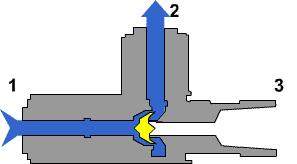Quick Exhaust Valves are one of the most common upgrades installed on Electro Cockers. I have heard the claim that they can make a gun faster, shoot smoother, and even more consistent over the chrono. All of those are true in SOME situations. Some of them may never be true, depending on how you set the gun up.
First, we’ll cover how a QEV works:
There are three ports on the QEV. There is an input, an output, and an exhaust port. On MPP QEVs, the input is the longer female threaded port, the output is the male threads that go into the ram body, and the exhaust is the shorter female threaded port. They are NOT interchangeable. If you have the input pressure going into the exhaust port, the QEV will be nothing more than a 90 degree fitting, with no advantage to performance at all.

Inside the main body of the QEV is a small cone shaped diaphragm (the yellow part in the diagram) that can float forward and back, controlling where the pressure is routed.
When pressure is applied to the input port (1) on the QEV, the diaphragm is shifted to the back, blocking the exhaust port (3). This allows pressure to flow into the ram (2), forcing the ram to extend or contract.
After the gun cycles, the input pressure to the ram drops, and the pressure in the ram forces the diaphragm to the front, sealing the input port, and exposing the exhaust port. At that point, the pressure in the ram drains out of the exhaust port.
So, what’s the point? Well, autocockers have a lot of restrictions to the gas flow on the front end. Pressure has to go from the three way, through a small hose, turn 90 degrees, go into the ram to extend it, then it has to be pushed back out when the ram cycles to close. All of those restrictions have to be overcome by the ram as it cycles. The more volume of air that has to be moved, and the longer the path it has to follow, the more resistance there is. A QEV solves that by giving the air a quick and easy path out of the system, and that easier path means less resistance in the ram’s cycle.
All the theory is well and good, but what does that lowered resistance in the ram mean to the performance of the gun on the field?
That can get a little murky.
By lowering the resistance in the ram, the gun can cycle at amazing speeds with the same input pressure.
OR
By lowering the resistance in the ram, the gun can cycle at the same speed, with less input pressure.
OR
By lowering the resistance in the ram, the above two options can be balanced. A faster cycle (but not as fast as it could be) at a lower input pressure (but not as low as it could be).
As with most things involving an Autococker, it’s a balancing act, and personal preference as to which you choose.
Some people want pure speed, so the set the gun up with the LPR as high as they can stand, and run their CON and COFF settings as low as they can get them. The up side is the gun is faster. The down side is that the gun is nowhere near as smooth, and will feel down right chunky when it cycles.
Others, myself included, enjoy the speed, but would rather focus on a USABLE ROF, and a much smoother cycle. In that case, follow your normal setup, and enjoy the lower LPR setting as a result.
One thing to note on mechanical cockers using two QEVs is that they do increase the cycle speed of the ram, and that can dramatically affect the timing of the gun. Mech cockers rely on a mechanical and slight pneumatic delay to the cycle to get the correct timing. By mounting two QEVs, you remove a lot of the cushion that those slight delays create.
The answer is simple: Use one QEV on the base of the ram, closest to the front block.
This will allow a reduction in the LPR setting by reducing the resistance as the ram cycles back, but keep the pneumatic delay in the cycle on the forward stroke. This works because the LPR is going to be set to the pressure required to compress the hammer spring, but there is a lot less force required to close the bolt once the spring is compressed.
A couple of closing points:
One thing to be aware of is that QEVs allow the ram to move faster, which can make the ram compress it’s bumper more, so you may need a slightly larger gap between the back block, and the body to prevent a slight slapping as the ram’s bumper compresses.
If you are using one QEV, use it on the base of the ram. If you mount it on the front of the ram, you increase the speed as the bolt closes, where it needs the reduced resistance the least. The forward stroke is already over pressurized because it’s not compressing the main spring, so there’s really no need to speed it up any more. If you mount the QEV on the rear of the ram, you can reduce the LPR setting, and/or enjoy the smoother cycle of the lower LPR setting to go with it.

